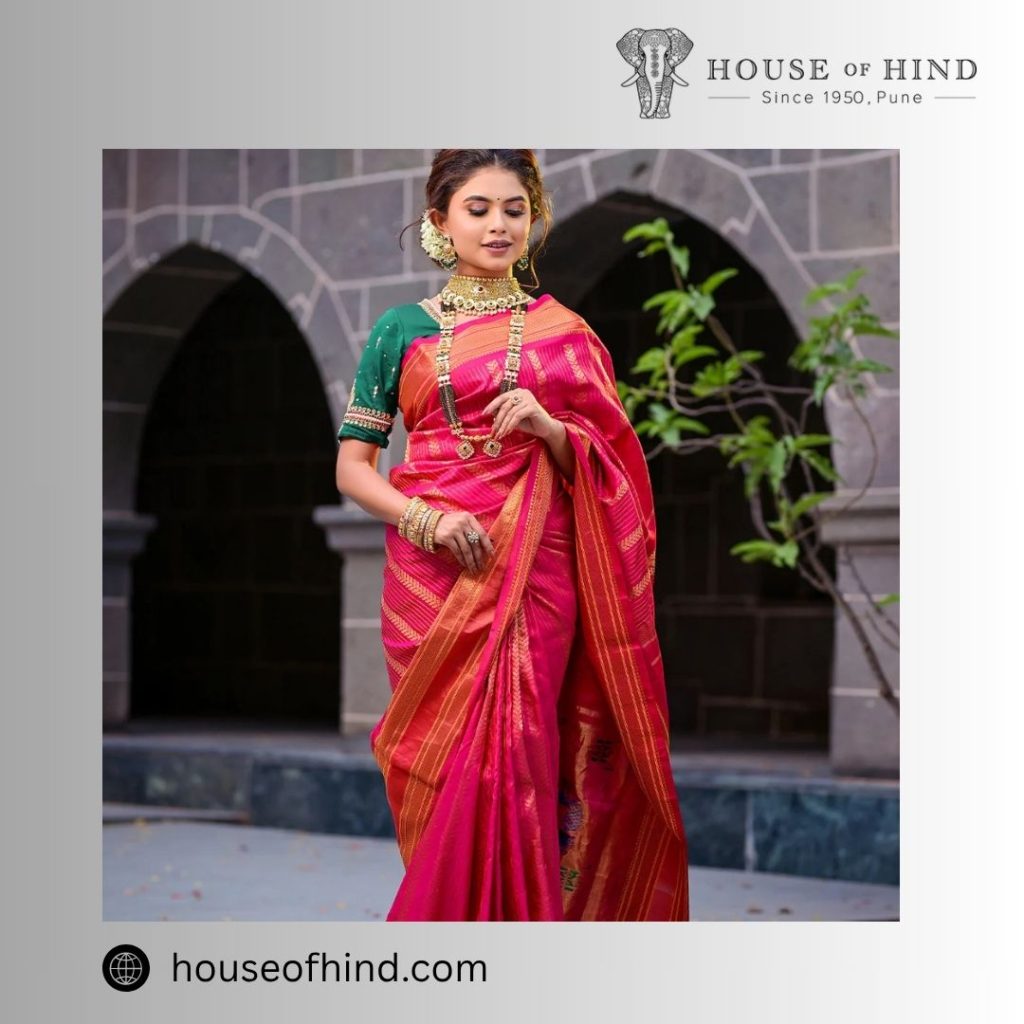India’s textile heritage is an intricate tapestry of culture, color, and craftsmanship—and among its crowning jewels stands the Paithani saree. Originating from the town of Paithan in Maharashtra, this saree isn’t merely a garment; it is a centuries-old art form that carries the pride of artisans who have devoted their lives to preserving its authenticity. Each weave tells a story of devotion, patience, and royal grandeur—making the Paithani saree a timeless masterpiece in Indian fashion.
The Origins of the Paithani Saree: A Royal Beginning
The Paithani saree has its roots in over 2,000 years of history. It was first woven during the Satavahana dynasty and later flourished under the patronage of the Peshwas and Maratha royals. The saree’s vibrant zari borders, golden peacock motifs, and intricate floral designs were once symbols of royalty—often worn by queens and nobility during grand occasions. What sets the Paithani apart from other Indian sarees is its pure silk base and handwoven metallic threads that shimmer with unmatched elegance.
Even today, artisans from Yeola and Paithan continue to preserve this cultural treasure, crafting each saree entirely by hand. Every motif, color, and weave reflects the essence of Maharashtra’s regal legacy—passed down through generations of weavers who have mastered this fine art.
The Art and Technique Behind Paithani Weaving
Crafting a Paithani saree is a slow, soulful process. The creation begins with selecting the finest silk threads, which are then dyed using natural or vegetable-based colors. Once prepared, the silk is stretched across the loom, and the magic begins.
The hallmark of the Paithani saree lies in its handwoven motifs—especially the mor (peacock), bangdi mor (peacock within bangle), lotus, and asawalli (flowering vine) patterns. These motifs are not printed but woven intricately into the fabric using a tapestry technique called kadiyal. This ensures that both sides of the saree mirror each other perfectly—an indicator of a truly authentic Paithani.
It can take anywhere from 30 days to 6 months to complete a single saree depending on the design complexity. The zari used is traditionally made of pure gold or silver threads, giving the saree its distinctive luster. The end result is a masterpiece—vivid, durable, and uniquely Indian.
The Evolution of Paithani: From Tradition to Modern Elegance
Over centuries, the Paithani saree has evolved from being a royal drape to an essential part of Indian bridal trousseaus and festive wardrobes. While traditional designs remain timeless, modern designers have infused innovation into this ancient craft.
Today’s Paithanis come in a variety of shades—pastels, dual tones, and ombre effects—appealing to younger generations who wish to blend heritage with contemporary style. Some modern adaptations include lighter zari work for easier wearability and fusion drapes for destination weddings or festive events.
Despite these innovations, the soul of the saree remains untouched. The same painstaking technique, rich motifs, and authentic silk continue to uphold the true spirit of Paithani weaving.
Preserving the Heritage of Paithani Weaving
In recent years, several initiatives have been launched to support Paithani weavers and ensure this heritage craft doesn’t fade away. Cooperatives, design houses, and online platforms are now helping artisans reach global audiences. By combining traditional artistry with digital accessibility, the legacy of Paithani weaving continues to thrive in the 21st century.
At the heart of this preservation lies the dedication of artisans—men and women who spend months perfecting each saree. Their skill, passed down from generation to generation, ensures that the Paithani remains not just a fabric, but a living story woven in silk and gold.
Paithani Saree Online: A Global Revival of Indian Heritage
In today’s digital era, the elegance of this traditional attire is accessible worldwide through curated collections of Paithani saree online. Shopping online allows customers to explore designs from Yeola and Paithan artisans, compare patterns, and understand the craftsmanship behind each weave.
Websites like House of Hind offer a platform that celebrates authentic handloom artistry. They feature genuine Paithani sarees directly from skilled weavers, helping preserve the legacy while connecting tradition with modern fashion. Whether you’re a bride-to-be or a saree enthusiast, exploring Paithani sarees online gives you the opportunity to own a piece of India’s rich textile story.
How to Identify a Genuine Paithani Saree
With growing popularity, many machine-made replicas flood the market, often sold at low prices that mislead buyers. Identifying a genuine Paithani saree is crucial to preserving the authenticity of this art form. Here are some key points:
- Check both sides: The reverse of a true Paithani will mirror the front exactly.
- Test the zari: Authentic zari is metallic, not plastic-coated.
- Observe the weave: Handwoven sarees have minor irregularities that add to their charm.
- Origin tags: Many genuine pieces come with a Geographical Indication (GI) tag, marking their origin from Maharashtra.
When purchasing a Paithani, always opt for certified sources or trusted handloom outlets. Supporting original weavers ensures the art continues to flourish while helping rural artisans earn fair wages.
Why Paithani Sarees Remain Timeless
Few garments hold the ability to bridge centuries of tradition with modern style the way Paithani sarees do. From Maharashtrian brides to Bollywood divas, their grace is universal. The saree’s brilliant hues, exquisite borders, and regal charm make it a statement of power, beauty, and heritage.
Whether it’s a wedding, religious ceremony, or festive occasion, a Paithani effortlessly elevates the wearer with sophistication and grace. It’s not just an outfit—it’s an emotion, a connection to the past, and a promise of enduring beauty.
Buy Paithani Saree: Celebrate Tradition with Every Drape
There’s something truly special about draping an authentic Paithani. The weight of its zari, the softness of its silk, and the richness of its history make every wearer feel royal. If you’re ready to embrace the artistry and tradition of Indian weaving, explore the exclusive collection and Buy Paithani saree from House of Hind.
Each saree in their collection reflects not just luxury, but legacy—crafted by handloom artisans who pour centuries of skill into every thread. When you buy a Paithani saree, you don’t just own a piece of clothing—you become part of a living tradition that celebrates India’s cultural brilliance.
Conclusion: Weaving Culture, Heritage, and Heart
The Paithani saree represents the heart of Indian craftsmanship—a living testament to our heritage. Every thread is an echo of history, every motif a mark of pride, and every saree a celebration of womanhood and artistry.
As India moves forward, the continued appreciation and support for this art form ensure that future generations will also experience the same royal elegance that once adorned queens. Owning a Paithani is more than fashion—it’s about preserving art, supporting artisans, and celebrating India’s cultural excellence.
So the next time you think of adding timeless grace to your wardrobe, look no further than the Paithani saree—a masterpiece woven not just with silk and zari, but with devotion and history.







